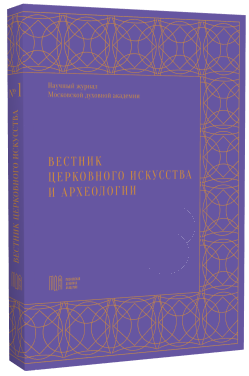The Program Bases of the Altar Murals at the New Tokali Kilise Church: Reasons for including the Holy Scripture Subjects in Altar Paintings
DOI:
https://doi.org/10.31802/BCAA.2022.6.1.002Keywords:
iconography, Byzantine monumental painting, altar mural paintings, liturgical plots, Byzantine riteAbstract
The formation of the liturgical program of the monumental decoration of the Byzantine church of the Middle Byzantine period was reflected in the inclusion in the altar paintings of themes and plots related to Byzantine rite. This article is devoted to the study of liturgical circumstances that led to the appearance of a cycle of gospel plots in the painting of the central altar of the church of New Tokali Kilise. All compositions presented relate to a Рassionate cycle. In the conch of the central apse is the scene of the Crucifixion of the unfolded iconographic exodus, below on the wall are the Removal from the Cross, the Position in the coffin, the Resurrection in the form of Descent into Hell and the Appearance of the Angel to the Wives of Myrrh-bearing. In the center between the compositions was the image of St. Basil the Great. The subject of the suffering of the Savior and his Resurrection is foreshadowed by the prophets Jeremiah and Ezekiel, whose images are placed on the slopes of the altar arch in front of the apse. The compositions presented in the altar correspond to the events listed in the text of the anaphora of Vasily the Great, being its picturesque embodiment. The saint, one of the Great Cappadocians, was especially revered by the compilers of the painting program of New Tokali, who placed his life cycle in naos. An analysis of the decoration program of the central apse of the church of New Tokali Kilis indicates that already in the Macedonian era, long before the appearance of illustrative liturgical cycles in the paintings, the structure of the altar decoration is formed, corresponding to the structure of the liturgical rank, revealing in the images the theme of offering a Eucharistic sacrifice.
Downloads
References
Амиранашвили Ш. Хахульский триптих. Тбилиси: Хеловнеба, 1972.
Беручашвили H., Бичикашвили И. Новая атрибуция креста Квирике хахульского складня // Византийский временник. 2002. Вып. 61(86). С. 172–184.
Герман Константинопольский, свт. Сказание о Церкви и рассмотрение таинств. М.: Мартис, 1995.
Карабинов И. А. Евхаристическая молитва (Анафора): Опыт историко-литургического анализа. СПб.: Тип. В. Киршбаума, 1908.
Квливидзе Н. В. Роспись церкви Мерьемана в Гёреме (капелла 33): формирование ктиторских программ в монастырском искусстве Каппадокии // Российское византиноведение. Традиции и перспективы. Тезисы докладов XIX Всероссийской научной сессии византинистов. М.: Московский университет, 2011. С. 112–114.
Лявданский А. К. Иеремии пророка книга // ПЭ. Т. 21. М., 2009. С. 261–278.
Розанов Н. П. Книга пророка Иеремии // Лопухин А. П. Толковая Библия. Т. 6. СПб.: [Б.и.] (Беспл. прил. к ж. «Странник»), 1909. С. 1–152.
Тетерятникова Н. Б. Двойная алтарная преграда Новой церкви Токали в Каппадокии // Иконостас: Происхождение,развитие,символика / сост.А.М.Лидов.М., 2000.С. 118–133.
Успенский Н. Д. Анафора: Опыт историко-литургического анализа // БТ. 1975. Сб. 13. С. 40–147.
Bernardini L. Les donateures des églises de Cappadoce // Byzantion. 1992. Vol. 62. P. 118–140.
Cormack R. Byzantine Cappadocia: The Archaic Group of Wall-Paintings // Journal of the Archaeological Association. 3rd series. 1967. Vol. 30. P. 19–36.
Delehaye H. Synaxarium Ecclesiae Constantinopolitanae. Bruxelles: Apud Socios Bollandianos, 1902.
Demus O. Byzantine Mosaic Decoration. Aspects of Monumental Art in Byzantium. Boston, 1955.
Jerphanion G. de. Une nouvelle province de l’art Byzantin. Les églises rupestres de Capadoce. Vol. 1. Paris: P. Geuthner, 1925.
Jolivet-Levy C. Aspects de la relation entree space liturgique et décor peint a Byzance // Art, Cérémonial et Liturgie au Moyen Âge. Roma: Viella, 2002. P. 71–88.
Jolivet-Levy C. Les églises byzantines de Cappadoce. Le programme iconographique de l’apside et de ses abords. Paris: Éd. du Centre nat. de la rech. sci., 1991.
Ousterhout R. A Bizantine settlement in Cappadocia. Washington, D.C., 2005. (Dumbarton Oaks Studies, XLII).
Restle M. Studien zur fruehbyzantinischen Architektur Kappadokiens. Vienne: Oesterreichische Akademie der Wissenschaften, 1979. (Philosophisch-Historische Klasse Denkschriften; Bd. 138).
Rodley L. Cave Monasteries of Byzantine Cappadocia. Cambridge: Cambridge University Press, 1985.
Stefanescu J. D. L’illustration des liturgies dans l’art de Byzance et de ’Orient. Brussels: Institut de Philologie et d’Histoire Orientales, 1936.
Taft R. F. The Great Entrance a History of the Transfer of Gifts and other Preanaphoral Rites. Roma: Pont. Institutum Studiorum Orientalium, 1978. (A History of the Liturgy of st. John Chrysostom, vol. 2).
Taft R. F. The Liturgy of the Hours in East and West. The Origins of the Divine Office and its Meaning for Today. Second Revised Edition. Collegeville, MN: Liturgical Press, 1993.
Teteriatnikov N. The Liturgical Planing of Byzantine churches in Cappadocia. Rome: Pontificio istituto orientale, 1996.
Thierry N. La Cappadoce de l’Antiquité au Moyen Âge. Turnhout: Brepols Publ., 2002.
Thierry N. La peinture de Cappadoce au Xe siècle. Recherches sur les commanditaires de la Nouvelle Eglise de Tokali et autres monuments // Constantine VII Porphyrogenitus and His Age. Second International Byzantine Conference. Delphi, 22–26 July 1987. Athens: European Cultural Center of Delphi Publ., 1989. P. 217–233.
Walter С. La place des évêques dans le décor des absides byzantines // Révue de l’art. 1974.
P. 81–89.1
Downloads
Published
How to Cite
Issue
Section
Categories
License

This work is licensed under a Creative Commons Attribution-ShareAlike 4.0 International License.



